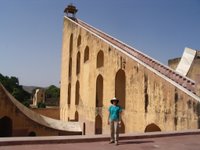Golden Triangle Jaipur – Got Time?
 Among our stops in Jaipur was the Astronomical Observatory. Those anticipating a glimpse into the deep depths of the universe from some high tech telescope would be disappointed. Rather, we visited the astronomical garden built in the early 1700’s by the Maharaja Jai Singh II of Amber, a contemporary of the Mughal emperor Aurangzeb.
Among our stops in Jaipur was the Astronomical Observatory. Those anticipating a glimpse into the deep depths of the universe from some high tech telescope would be disappointed. Rather, we visited the astronomical garden built in the early 1700’s by the Maharaja Jai Singh II of Amber, a contemporary of the Mughal emperor Aurangzeb. Maharaja (meaning King) Jai Singh II was also known as Sawai Jai Singh II. The term sawai means “one and a quarter man,” meaning Sawai Jai Singh II had the power and intellect of 1 ¼ men. This tradition of being a cut above the ordinary man continues today in the Palace City of Jaipur. Whenever the current maharaja is in residence, two flags fly above the palace; one a full size flag and the other a quarter-sized flag.
Maharaja (meaning King) Jai Singh II was also known as Sawai Jai Singh II. The term sawai means “one and a quarter man,” meaning Sawai Jai Singh II had the power and intellect of 1 ¼ men. This tradition of being a cut above the ordinary man continues today in the Palace City of Jaipur. Whenever the current maharaja is in residence, two flags fly above the palace; one a full size flag and the other a quarter-sized flag.Sawai Jai Singh II built a yantra mandir (temple of instruments) in Delhi and a
 larger one in Jaipur. We visited the Jaipur “temple.” The astronomical garden is filled with large stone and metal instruments created for the purpose of telling time and indicating the movements of the sun, moon and planets. India is a land where important events are scheduled at “auspicious” times. Without access to accurate time or the correct position of the planets, one might marry, start a military campaign or lay the corner stone to a temple at an inauspicious time and disaster may follow. Sawai Jai Singh II would have none of that!
larger one in Jaipur. We visited the Jaipur “temple.” The astronomical garden is filled with large stone and metal instruments created for the purpose of telling time and indicating the movements of the sun, moon and planets. India is a land where important events are scheduled at “auspicious” times. Without access to accurate time or the correct position of the planets, one might marry, start a military campaign or lay the corner stone to a temple at an inauspicious time and disaster may follow. Sawai Jai Singh II would have none of that! The observatory consists of fourteen major geometric structures. The Samrat Jantar, the largest instrument, is a 90 ft. high sundial that casts a shadow that carefully and accurately plots the time of day. A smaller version of the sundial was earlier constructed to work out design considerations. Its time keeping is equally accurate, even in this day of expensive digital wristwatches. Amazing!
The observatory consists of fourteen major geometric structures. The Samrat Jantar, the largest instrument, is a 90 ft. high sundial that casts a shadow that carefully and accurately plots the time of day. A smaller version of the sundial was earlier constructed to work out design considerations. Its time keeping is equally accurate, even in this day of expensive digital wristwatches. Amazing!The Jaya Prakas, used to predict the location of the sun, has two concave bowls in
 pits “working” alternate hours. The complementary bowls are designed so a missing section in one bowl is matched with a fully scribed stone slab in the other bowl. The design of the bowls (dug into the ground) was rooted in the simple and pragmatic need to allow someone to get close enough to accurately read the shadows cast on the instrumentation etched in the stone slab. Astounding!
pits “working” alternate hours. The complementary bowls are designed so a missing section in one bowl is matched with a fully scribed stone slab in the other bowl. The design of the bowls (dug into the ground) was rooted in the simple and pragmatic need to allow someone to get close enough to accurately read the shadows cast on the instrumentation etched in the stone slab. Astounding! Our guide told us the cylindrical Ram Yantra masonry instrument, designed to make local coordinate measurements of objects in the sky, was a bust. He indicated that something in design or construction rendered it a non-functioning instrument.
Our guide told us the cylindrical Ram Yantra masonry instrument, designed to make local coordinate measurements of objects in the sky, was a bust. He indicated that something in design or construction rendered it a non-functioning instrument.Regardless of the accuracy of our tour guide, there is no doubt that Sawai Jai Singh II was, indeed, a man of unusual and uncanny intellect.

1 Comments:
Easily one of the best tours in India, the Golden Triangle Tour is mandatory for those fascinated with the history, culture and traditions of the country.
Post a Comment
<< Home